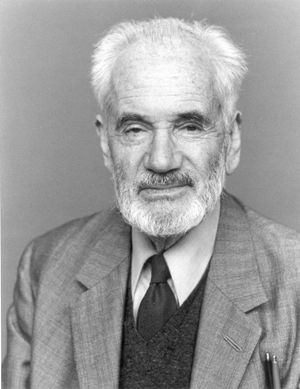Otto Robert Frisch, FRS
1904-79.  Nuclear physicist. Jacksonian Professor of Natural Philosophy; Head of Harwell Atomic Research Establishment.
Nuclear physicist. Jacksonian Professor of Natural Philosophy; Head of Harwell Atomic Research Establishment.
Frisch was born in Vienna, the son of painter Justinian Frisch and concert pianist Auguste Meitner Frisch. He himself was talented at both but also had inherited his aunt Lise Meitner's love of physics and commenced a period of study at the University of Vienna, graduating with some work on the effect of the newly discovered electron on salts. After some years working in relatively obscure laboratories in Germany, Frisch obtained a position in Hamburg under the Nobel laureate Otto Stern. Here Frisch produced novel work on the diffraction of atoms (using crystal surfaces) and also proved that the magnetic moment of the proton was much larger than had been previously supposed.
The accession of Hitler to the chancellorship of Germany in 1933 made Frisch, a Jew, make the decision to move to London where he joined the staff at Birkbeck College and worked with the physicist P.M.S. Blackett on cloud chamber technology and artificial radioactivity. He followed this with a five-year stint in Copenhagen with Niels Bohr where he increasingly specialised in nuclear physics, particularly in neutron physics.
During the Christmas holiday in 1938 he visited his aunt Lise Meitner in Kungälv. While there she received the news that Otto Hahn and Fritz Strassmann in Berlin had discovered that the collision of a neutron with a uranium nucleus produced the element barium as one of its byproducts. Hahn, in a letter to Meitner, called this new reaction a "bursting" of the uranium nucleus. Frisch and Meitner hypothesized that the uranium nucleus had split in two, explained the process, estimated the energy released, and Frisch coined the term fission to describe it. Political restraints of the Nazi era forced the team of Hahn and that of Frisch and Meitner (both of whom were Jewish) to publish separately. Hahn's paper described the experiment and the finding of the barium byproduct. Meitner's and Frisch's paper explained the physics behind the phenomenon. Frisch went back to Copenhagen, where he was quickly able to isolate the fragments produced by fission reactions. As Frisch himself later recalls, a fundamental idea of the direct experimental proof of the nuclear fission was suggested to him by George Placzek.
In the summer of 1939 Frisch left Denmark for what he anticipated would be a short trip to Birmingham, but the outbreak of war precluded his return. With war on his mind, he and the physicist Rudolf Peierls produced the Frisch-Peierls memorandum, which was the first document to set out a process by which an atomic explosion could be generated; their process would use separated Uranium-235, which would require a fairly small critical mass and could be made to achieve criticality using conventional explosives and create an immensely powerful detonation. The memorandum went on to predict the effects of such an explosion — from the initial blast to the resulting fallout. This memorandum was the basis of British work on building an atomic device (the Tube Alloys project) and also that of the Manhattan Project on which Frisch worked as part of the British delegation. He went to America in 1943 having been hurriedly made a British citizen.
In 1944 at Los Alamos, one of Frisch's tasks as the leader of the Critical Assemblies group was to accurately determine the exact amount of enriched uranium which would be required to create the critical mass, the mass of uranium which would sustain a nuclear reaction. He did this by stacking several dozen 3 cm bars of enriched uranium hydride at a time and measuring rising neutron activity as the critical mass was approached. The hydrogen in the metal bars increased the time that the reaction required to accelerate. This was dubbed "tickling a sleeping dragon's tail" by Richard Feynman, as too many bars would cause a runaway reaction that would have melted the bars and killed everyone nearby with neutron radiation. One day Frisch almost caused a runaway reaction by leaning over the stack. The hydrogen in his body reflected neutrons back into the stack. Out of the corner of his eye he saw the flashing red counter light go solid on. Realizing what was happening, Frisch quickly scattered the bars with his hand. In two seconds he received, by the generous standards of the time, a full day's permissible dose of neutron radiation. In this way his experiments determined the exact masses of uranium required to fire the Little Boy bomb over Hiroshima.
In 1946 he returned to England to take up the post of head of the nuclear physics division of the Atomic Energy Research Establishment at Harwell, though he also spent much of the next thirty years teaching at Cambridge where he was Jacksonian Professor of Natural Philosophy and a Fellow of Trinity.
Before he retired in 1972 he designed a device, SWEEPNIK, that used a laser and computer to measure tracks in Bubble chambers. Seeing that this had wider applications, he helped found a company, Laser-Scan Limited, now known as 1Spatial, to exploit the idea.
| Memorial inscription | Translation |
|
OTTO ROBERT FRISCH PATRIA EXVL SVA IN NOSTRAM ADSCITVS |
Exiled from his own country, Otto Robert Frisch was naturalised here. A highly skilled researcher into atomic structure, he was Jacksonian Professor of Natural Philosophy and a Fellow of this College for thirty-one years. He contributed much in debate and in conversation as well as being a music-lover and pianist. He died in 1979 at the age of seventy-four. |
Otto Robert FrischBrass located on the north wall of the Ante-Chapel. |
Click on the thumbnail for a larger image. |
|
|
PREVIOUS BRASS |
|
NEXT BRASS John Andrew Gallagher |
| Brasses A-B | Brasses C-G | Brasses H-K | Brasses L-P | Brasses R-S | Brasses T-W |

